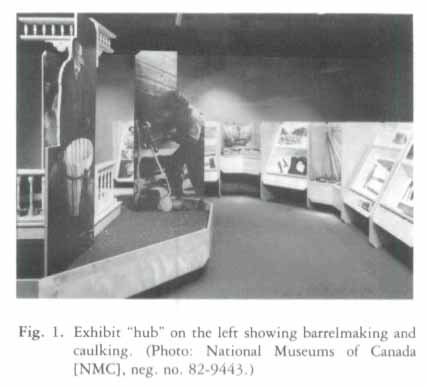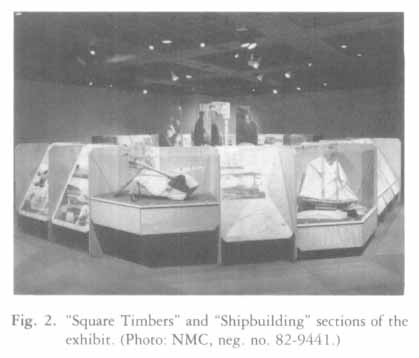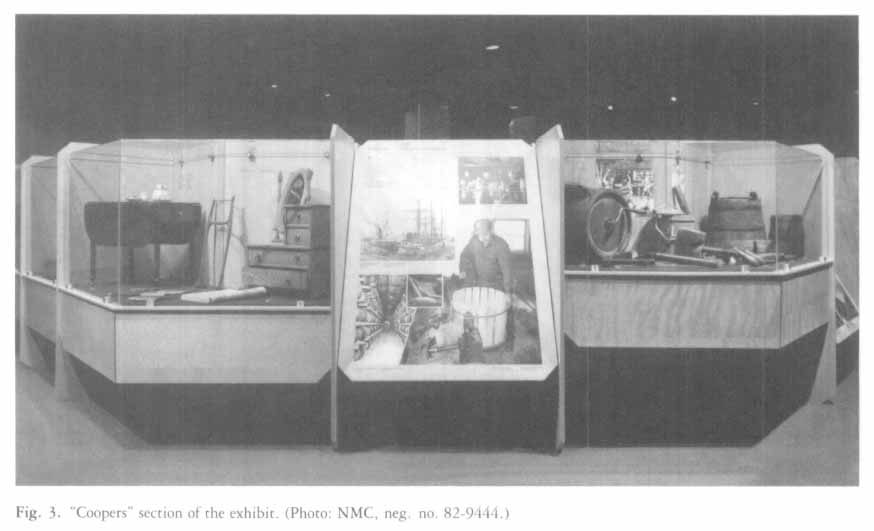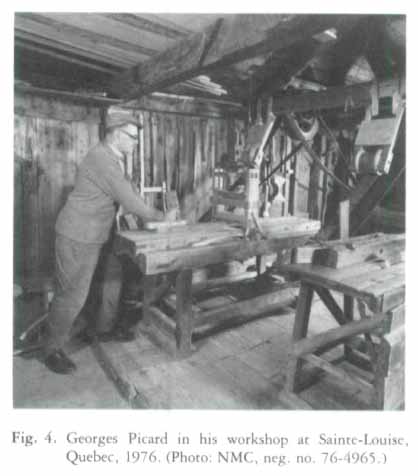Reviews / Comptes rendus
National Museum of Man, "Of Men and Wood"
1 Veteran museum-goers often see exhibits that glorify the "marvels" of modern technology in this or that industry. Fortunately, this exhibit presents a less egregious interpretation of the history of the forest industries of eastern Canada because it reveals, as the others usually fail to do, how industrial capitalism has impinged upon the lives of workers caught up in the world of wood. The exhibit warns viewers that the reality of the lumberjack's life contrasted sharply with the romantic images spawned by songs and stories, although the reasons for this tend to remain buried in a montage of pictures, artifacts, and text. The fact that the human "commodity" in forest enterprise receives as much emphasis as forest products is certainly welcome. But its creators waffle at the end by concluding their display on an ambiguous note of concern for the forest environment rather than for today's woodworkers.
 Display large image of Figure 1
Display large image of Figure 1 Display large image of Figure 2
Display large image of Figure 22 "Of Men and Wood" is a self-contained, portable display designed for easy installation in one exhibition hall. Organized in the shape of a large wheel made up of natural wood-finished cases, the hub contains a central display of four large cut-out photographs of workers which immediately attract the viewer's attention. Each of the four is fashioning wood: one drills a piece mounted on a vise, another wields an axe in the woods, a third makes a barrel, and a fourth hammers caulk into the side of a sailing vessel. The full-scale corner of a Victorian porch railing nearby shows both the woodworker's attractive handiwork and many of the tools of his trade. The chronologically arranged cases circling these cut-out figures contain a wide assortment of maps, pictures, photos, drawings, models, and artifacts ranging over two centuries of Canadian history.
3 The exhibit is organized around two major themes. "Wood and the Economy" chronicles the history of North American forest resources from the rise of the square timber trade in the late eighteenth century through wooden shipbuilding and house construction to the pulp and paper industries of more recent times. The chief historical periods are effectively delineated by way of maps, pictures, ship models, and by various tools associated with these work-places, such as axes, adzes, augers, trammel points, and caulking and sailmaking tools. The purpose of most if not all these artifacts (i.e., what are trammel points?) is satisfactorily explained. To convey the atmosphere of twentieth-century forest resource factories, the exhibit relies upon some excellent photographs of the interiors of pulp and paper mills or sawmills as well as on an interesting display of paper products garbed in the colourful advertising slogans and brand names of yore. The text accurately emphasizes the historical dependence of the eastern Canadian forest industry upon British and American markets, and curiously overlooks other dimensions of dependence upon foreign capital and technique. The lumber slide, for instance, was introduced into Canada by New England forest entrepreneurs. Nowhere is data on either the volume or value of forest-related exports to British or American metropolitan centres provided, and consequently the cyclonic fluctuations of this export-led economy also go unnoticed.
 Display large image of Figure 3
Display large image of Figure 34 The second and more original theme portrays the experiences of generations of woodworkers, detailing their seasonal work in the forests through pictures and a model of a logging camp. An excellent combination of pictures and tools conveys accurate impressions about the work-place lives of carpenters and joiners, cabinetmakers and coopers. These displays, and especially the accompanying brochure, explain why working conditions peculiar to the forest industry kept workers for the most part on the fringes of the nineteenth-century Canadian labour movement. But the pictures of individual workers taken together overemphasize isolating factors and obscure the many examples of spontaneous collective action by lumbermen and woodworkers in defence of their interests. Instead of baldly summarizing the results of the changing social relations of production, however, the exhibit concludes by pondering the impending destruction of the forest environment: "Given that today's technology renders intensive cutting more feasible than ever, can we afford to continue invading new regions and increasing the rate of exploitation?" Put this way, the exhibit suggests that technology is a purely autonomous force. Actually, profits — not technology — have always dictated both when and how machines were introduced into the wilderness work-place and also the degree to which the environment was exploited.
5 Despite falsely interpreting technological change as an independent variable rather than a conscious option available to entrepreneurs, I thought that "Of Men and Wood" effectually blended a wide range of artifacts, maps, pictures, and drawings into a basically accurate and persuasive historical interpretation. The single most objectionable feature about the exhibit originated in Saint John rather than in Ottawa. New Brunswick Museum officials did absolutely nothing to enhance this display. Atrocious lighting put some parts of it in a dazzling glare and other parts in deep shadow. Stark white, bare walls ought to have been draped in fabric if no posters or pictures were available. The absence of any noise associated with woodworking industries could have been overcome through a continuous tape recording of sawing, hammering, and other workshop sounds interspersed with the chitchat of workers. This viewer longed for a whiff of pine needles or cedar staves.
 Display large image of Figure 4
Display large image of Figure 46 Inevitably a few of the photographs or reproductions left me puzzled or amused. The exhibit quotes the decision of Judge Tessier in Quebec on "freedom of contract" without explaining how that doctrine affected workers. One photograph (fig. 4), presuming to be of a carpenter-joiner at work in his shop, is obviously faked. The "worker" wears polished dress shoes, his belt-powered saw is not in motion, and the interior lighting is artificially dramatic. No bona fide woodworker would be caught pushing a board over a tablesaw with his hands rather than with a forked stick.
7 The accompanying brochure, Work in the Nineteenth-Century Forest Industry, fills in some gaps in the displays by discussing the quality of life in lumber towns and the erosion of artisan skills. It hints more directly at the changing social relations of production that coincided with the rise of forest-related factories. It is also more accurate in pointing out the links between profit-making and the threatened exhaustion of the resource base. By focusing exclusively on the nineteenth century though, the brochure is unaccountably narrower than the exhibit. And by concluding on a predictably popular nationalist theme (worry over control of the Canadian forest industry by United States and British interests), it implies without any evidence that Canadian capitalists would have made different decisions that gave more benefits to workers or showed more sensitivity to environmental issues. Finally, the brochure's bibliography omits some important references of general interest, such as Donald McKay's The Lumberjacks (Toronto, 1978) and Michael Cross's article on the Shiner's "war" in Canadian Historical Review (54, March 1973). All the items here should be annotated as well.
8 In sum, I would give an A-minus to the creators of this exhibit for their generally effective blend of artifacts and visual materials, for their explanatory captions, and especially for their stress on the work-place aspects of the forest resources industries. I lament their bland and misleading conclusion because it fails to point up the evolving social relationships between woodworkers and entrepreneurs that stemmed from changing modes of production. New Brunswick Museum officials receive a failing grade for their lack of attention to the exhibit setting; perhaps it is not surprising (if unfortunate) that no one else came to look at "Of Men and Wood" during the ninety minutes I was there.